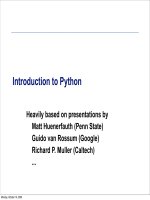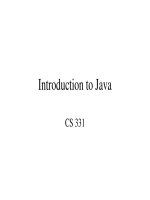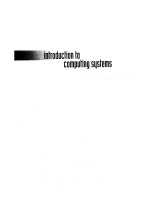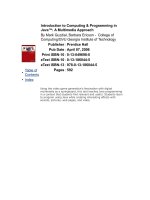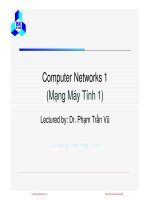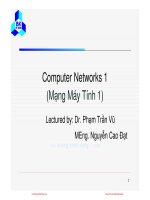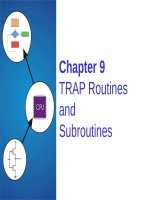Introduction to Computing: Lecture 11 - Dr. Pham Tran Vu
Bạn đang xem bản rút gọn của tài liệu. Xem và tải ngay bản đầy đủ của tài liệu tại đây (2.36 MB, 29 trang )
Introduction to Computing
Lectured by: Dr. Pham Tran Vu
Applications
Business Applications
Modelling and Simulation
Industrial and Control Applications
The Internet
Industrial Applications
Computer-Aided Design (CAD)
Computer-Aided Manufacture (CAM)
Industrial robots
Computer numerical control
Integrated CAD/CAM
Automatic materials handling
Flexible manufacturing systems
3
Computer-Aided Design
4
Computer-Aided Manufacture
Industrial robots
5
Control Systems
Used to control the operation of some process
Examples
Air conditioning systems, water heating systems, antilocking brake system (ABS), cruise control
Components of a control system
Input
Process
Output
Feedback
6
The Internet
World Wide Web
File Transfer Protocol
Intranet
E-Commerce
Internet security
7
Architecture of the Internet
8
Internet Connections
A computer can be connected to the Internet
using:
Corporate LANs
Wireless
Dial-up using a telephone line
ADSL – Asynchronous Digital Subscriber Line
Internet cable networks
TV cable networks
9
World Wide Web (WWW)
Was invented in 1989, by Tim Berners-Lee at
CERN
Based on client-server architecture
Components of the WWW:
Hypertext and hypermedia
Hypertext Transfer Protocol (HTTP)
Hypertext Mark-up Language (HTML)
Uniform Resource Locators (URLs)
Web browsers
Web servers
10
WWW Architecture Overview
The parts of the Web model.
11
The Client Side – Web Browsers
Steps carried out by the browsers
1.
2.
3.
4.
5.
6.
7.
8.
9.
The browser determines the URL (by seeing what was
selected).
The browser asks DNS for the IP address of www.itu.org.
DNS replies with 156.106.192.32.
The browser makes a TCP connection to port 80 on
156.106.192.32.
It then sends over a request asking for file
/home/index.html.
The www.itu.org server sends the file /home/index.html.
The TCP connection is released.
The browser displays all the text in /home/index.html.
The browser fetches and displays all images in this file. 12
The Client Side – Web Browsers (2)
To display contents other HTML, e.g. PDF file or a
movie clip, browsers use plug-ins or helper
applications
(a) A browser plug-in. (b) A helper application.
13
The Server-Side – Web Servers
Generally, steps that a server performs
1.
Accept a TCP connection from a client (a
browser).
2.
Get the name of the file requested.
3.
Get the file (from disk).
4.
Return the file to the client.
5.
Release the TCP connection
14
HTML
The language used for describing hypertext
documents
15
Some HTML Common Tags
16
Web Search Engines
Web search engines are most popular
WWW applications
Used to search for resources available on
the WWW
Famous search engines:
Yahoo
Live Search (Microsoft)
17
Electronic Mail – Email (or E-mail)
Has been around since the early days of
Internet
Is widely used today
Informal form of communication
Simple and easy to use
18
Electronic Mail (2)
Some smileys :-).
19
Email Message Structure
Envelopes and messages. (a) Paper mail. (b) Electronic mail.
20
Email Systems
Has two basic parts:
User agent: a program that accepts a variety of
commands for composing, receiving, and
replying to messages, as well as for
manipulating mailboxes
Message transfer agents: relaying messages
from the originator to the recipient
21
Email Delivery
(a) Sending and reading mail when the receiver has a permanent
Internet connection and the user agent runs on the same machine as
the message transfer agent. (b) Reading e-mail when the receiver has
22
a dial-up connection to an ISP.
Email Delivery (2)
Emails are transferred from a mail server to
another mail server using Simple Mail
Transfer Protocol (SMTP)
Emails are transferred from a mail server to
a user machine using:
POP3
IMAP
Web client (e.g. Gmail, Yahoo Mail)
23
FTP - File Transfer Protocol
user
at host
FTP
FTP
user
client
interface
local file
system
file transfer
FTP
server
remote file
system
• transfer file to/from remote host
• client/server model
– client: side that initiates transfer (either to/from remote)
– server: remote host
• ftp server: port 21
24
Intranets
A private network using Internet software
and TCP/IP protocol
E.g. a university intranet, a company
intranet
Intranets are usually connected to the
Internet
Some resources an intranet are not
accessible from the Internet
25
